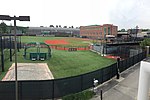Cold Regions Research and Engineering Laboratory

The Cold Regions Research and Engineering Laboratory (CRREL) is a United States Army Corps of Engineers, Engineer Research and Development Center research facility headquartered in Hanover, New Hampshire, that provides scientific and engineering support to the U.S. government and its military with a core emphasis on cold environments. CRREL also provides technical support to non-government customers. CRREL arose from a consolidation of three antecedent organizations whose purpose was to understand frozen ground, permafrost, snow and ice as factors which were important in strategic northern areas during the Cold War. In its first 25 years CRREL researchers contributed to the understanding of polar ice caps, permafrost, and the engineering technology for developing natural resources in cold climates, such as Alaska. More recently, CRREL researchers have made contributions to science in climate change, the understanding of wave propagation for sensor systems, the control of snow on structures and ice in navigable waterways, and the environmental remediation of military installations.
Excerpt from the Wikipedia article Cold Regions Research and Engineering Laboratory (License: CC BY-SA 3.0, Authors, Images).Cold Regions Research and Engineering Laboratory
Lyme Road,
Geographical coordinates (GPS) Address Website Nearby Places Show on map
Geographical coordinates (GPS)
| Latitude | Longitude |
|---|---|
| N 43.723888888889 ° | E -72.273055555556 ° |
Address
Cold Regions Research & Engineering Laboratory
Lyme Road 72
03755
New Hampshire, United States
Open on Google Maps







